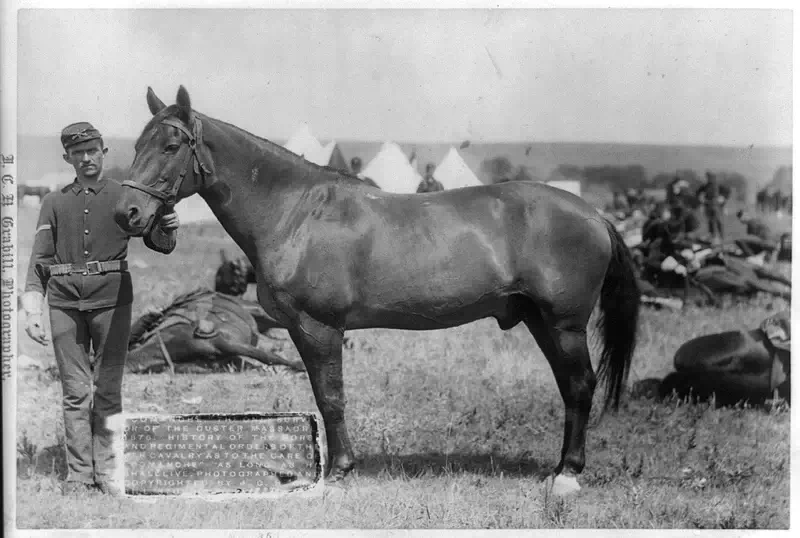
US Military History Throughout The Years
Short bits of history you know and some you may not!
- Comanche: Friday, November 6, 1891 – Comanche dies on this day and was thought to be 29 years old. Comanche was reputed to be the sole survivor of the Battle of Little Bighorn. The mix breed horse was bought buy US Army Captain Keogh as his personal horse to be ridden only in battle. The horse was found badly wounded two days after the battle and was transported to Ft Lincoln. After recovery Comanche was retired and orders covering his treatment followed him. As thought to be the only living representative of the battle he was to be treated kindly and his life was to be preserved to the utmost limit, he was also to never be ridden again or put to work. Comanche remains one of only four horses in US Military history to be given a military funeral with honors. Comanche can still be seen today as his remains were preserved and can be visited at University of Kansas Natural History Museum.
- The Marines Are Born: Friday, November 10, 1775 – During the Second Continental Congress a resolution would be passed that “two battalions of Marines be raised”. The Continental Marines would serve as a landing force for the recently created Continental Navy. The Continental Marines would be commanded by Captain Samuel Nicholas, who is recognized as the first Commandant of the Marine Corps. The Continental Marines would go on to serve with distinction during the Revolution, undertaking their first amphibious landing in March 1776 where they would occupy the British port of Nassau for two weeks. Following the end of the Revolution, both the Continental Navy and Marines would be disbanded due to the new United States being unable to afford them. It was not until 1789 that Congress would officially create the United States Marine Corps, in reaction to preparation of the Quasi-War with France. The USMC officially recognizes 10 November 1775 as the date they were created and celebrates their birth annually with Military Balls and other celebrations. The USMC has served with amazing distinction since their creation, taking part in immense battles and undertakings in the defense of all America holds dear.
- Andersonville Prison: Friday, November 10, 1865 – Henry Wirz, a Swiss American serving with the Confederacy during the Civil War is hung for war crimes following the end of the war. Wirz served as the commander of the Andersonville Prison in Georgia. The prison was incredibly harsh, with prisoners being held in inhumane conditions for years. The prison was more of a enclosed pit, with no real accommodation for Union Soldiers held there. Prisoners lived in makeshift tents and were without anything near proper food, medicine or sanitary conditions. The prison was filled to 4 times capacity, with 45,000 Union Soldiers being held their over the war. Nearly 13,000 of those wold die in the prison, mostly from disease. For his actions as commander of the prison, Wirz was executed for conspiracy and murder. Interestingly, Wirz would be the only person executed for crimes at the end of the war.
- Washington Naval Conference: Friday, November 11, 1921 – After the end of World War 1 and the general worldwide attitude towards peace the first arms control conference takes starts. Nine nations would meet regarding their respective interests in the Pacific Ocean and in East Asia. The talks would focus on disarmament and limiting naval power across all participating nations. A limit on the overall tonnage of ships within a navy would be limited, with the USA and Britain being afforded the largest and Japan and other nations smaller total tonnages. Certain ship types would be limited to overall size, such as battleships being no larger than 35,000 tons. With the overall size of a nations navy now limited many ships would be scrapped and others converted. During the conference several treaties would be formed as well, with nations making agreements with other nations with similar interests to limit expansion at the cost of peace. China in particular would be somewhat protected by the treaties formed, with all signing nations having to respect its independence and with China itself not able to favor any nation over another. The treaties and disarmament agreements would see the rest of the 1920’s for the most part a peaceful time period. The Great Depression and following increase of tensions in Europe and East Asia would see the treaties and limited strength of navies ignored in the years prior to WW2.
This week’s featured products.
Best-Selling Military Gear
-

North American Rescue GEN 7 CAT Tourniquet
$29.99 Select options -

USGI M249 SAW Ammo Box, 200 Round
$11.99 – $16.99 Select options -

Eagle Industries Double M4 Mag Pouch
$3.99 Select options -

USGI Military Poncho Liner, Woobie Blanket
$19.99 – $49.99 Select options -

USGI 6 Magazine Bandoleer
$3.99 – $21.99 Select options -

USGI 1 Quart Canteen
$5.49 Select options -

North American Rescue Compressed Gauze
$4.99 Select options -

North American Rescue Survival Blanket
$1.59 Select options








